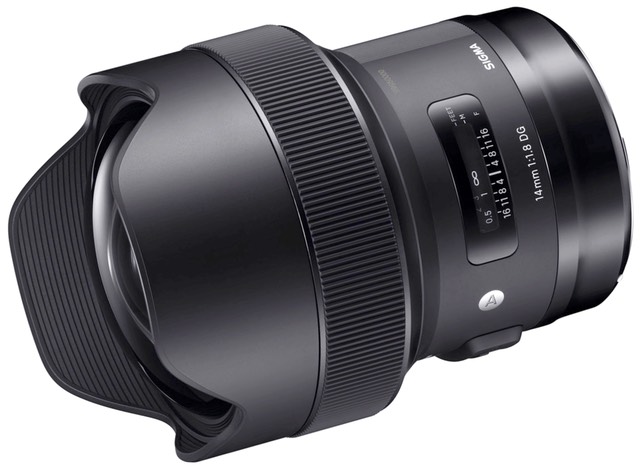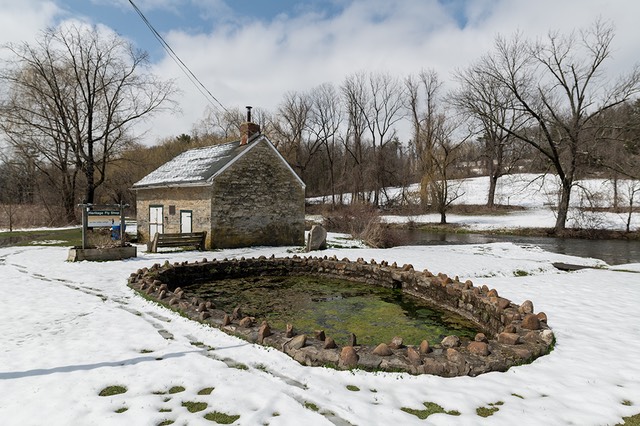
What is It?
The Sigma 14mm f/1.8 HSM Art is one of the recent prime lenses that show Sigma pushing into new arenas. We now have fast Art primes from 14mm to 135mm, and as you might have noticed, those are all getting lots of attention from the review sites and serious photographers.
If you remember Sigma from the old much-less-expensive-than-Canikon days, the whole Art initiative is a serious move upscale for Sigma. Build quality is better, optical quality is better, consistency in manufacturing appears better: this is not your father's Sigma.
14mm is seriously wide, and this is a lens that covers the full 24x36mm frame (FX for Nikon users). Corner to corner diagonally, that works out to about 114°. Do me a favor. Stand up. Hold out your arms. One arm straight in front of you, one exactly out to the side. Look at what's contained in between your arms. That's 90°. 14mm is seriously wide. Really seriously wide.
We can focus the lens down to about 11" (27cm). Your arms still out? Walk up a foot away from something and look at what's being framed with your arms. Again, seriously wide, and seriously going to impact depth cues if you use it close in like that (I'll demonstrate this a bit later in the review).
Yet with its f/1.8 aperture (goes to f/16), this lens doesn't need a lot of light. It's a stop and a third faster than my 14-24mm f/2.8 Nikkor. Indeed, a bit more than that it seems from t/stop measurements.
Internally, the optical formula is complex: 16 elements in 11 groups, with 4 aspherical elements, 3 FLD elements, and 4 SLD elements. The front element is a huge one, with the typical "bubble" effect you see with the really wide lenses. So bubbly, in fact, that you get a slip-on lens cap that goes over the built-in petal hood, and no filter rings. Unlike some recent slip-on caps, the one for this Sigma does not have indents or catches to hold it in place. Instead, a slight bit of felt around the inside rim is supposed to be the friction that holds it in place. I'm not sure that's going to wear well. And with other lens like this, I've found that dirt and grit collects on that felt over time.
This is a massive lens: 5" long by almost 4" round (126mm x 95.4mm), and 39.5 ounces (1120g). That's two and a half pounds sitting out front your camera body. I was a bit amused when Sigma announced a Sony FE version of this lens. That's 39.5 ounces hanging off the front of 23.2 ounces (A7R3), and it's longer in that version. So much for mirrorless being small and light.
Indeed, I heard a bunch of folk talking about using this lens for landscapes out hiking. Are you sure? You're at a minimum of four pounds with just body and lens, let alone anything else you bring along. I certainly don't want four pounds hanging off my neck while hiking. I'll have more to say about intended use later in the review.
The lens goes from near to far focus in a bit less than a quarter turn of the focus ring. There's a distance scale, and it's marked for DOF at f/4, f/8, f/11, and f/16. I did some back calculations: as usual, we don't have a lens marked correctly. If you're going by the Zeiss formula, the CoC should be 0.025 for full frame. It appears that once again the Japanese are rounding that off to at least 0.03. So be careful about assuming that the DOF scale is all you need to assess focus.
On the side of the lens is a AF/M switch. Focus ring. One switch. That's about it externally.
You can get a Rear Filter Holder (FHR-11) for the lens if you use Canon mount, which will allow you to use sheet filters, but I'm not a fan of that approach, and I'm not sure what filter you're really want to put back there. The lens is compatible with the Sigma USB dock, and lenses bought in one mount can be switched to another by Sigma service for a fee.
Source of the tested lens: B&H loaner
The lens is made in Japan, available in Canon EF, Nikon F, Sigma SA, and Sony FE mounts, and retails for US$1599. Curiously, Sigma has now started labeling lenses with the year in which they were born. My sample is from 2017. So post-millennial ;~).
How's it Handle?
In a word, heavy. It seems that's the price we pay these days for something new and unique and good, so I'm reviewing a lot of heavy gear lately. The Sigma 14mm f/1.8 Art reminds me a bit of the Nikkor 105mm f/1.4. On a DSLR you end up with over four pounds in your hand, and that's going to be a bit front-heavy with a fairly wide barrel out front.
So work out with weights.
Other than that, there's not much to say. The focus ring was smooth, the focus switch stiff, pretty much the way you want them.
How's it perform?
Focus: This is an HSM lens with an internal focus motor, and it's relatively quiet and fast. In a very close near to extreme far focus pull there's a brief slide to the focus point, but I judge that to be faster than the closest Nikkor f/1.8 prime. I did some basic 3D tracking tests, and at least out to the very extreme column on my D850 the lens does well keeping a face in focus (wait, the D850 does face detect focus? Yes, haven't you been reading my reviews and books?). Generally, wide angle lenses aren't problematic in focusing, as they don't move elements very far, and the Sigma seems to work as I'd expect in this regard.
Sharpness: Like all recent Art lenses from Sigma, center sharpness is outstanding. This is a lens that really will show off the high megapixel sensors, at least within the rule of thirds points and a bit beyond.
Wide open, the corners are decidedly less impressive on my D850. They might reach what I'd call good on a 16-24mp sensor, but the disparity between the center and corner on a high megapixel count camera is really tough to ignore. Of course, what other f/1.8 14mm lens do you know of, and what were you expecting?
So how do the corners work as we stop down? You pretty much have to get to the diffraction impact limit—f/5.6 or slightly higher on most of my high pixel count cameras—before we start seeing a really good balance between center and corner sharpness, but the center is starting to slump a bit stopped down that much.
This brings up the question of who this lens is for? At f/8 for landscapes, it's quite decent, but you don't get that popping-in-contrast central area as you do from f/2 to f/4. To put it in perspective, the very center of the lens is sharper at f/1.8 than f/8 in MTF tests (though beware that this is measured at a reasonably close distance, not landscape distances; I don't have a test chart big enough I can use for 14mm at long distances ;~). Indoors event shooting at f/1.8 you're going to get a wide capture area with a pretty stunning center, but be very careful about what's in the corners, as they will appear soft compared to the center, and there will be distortion (see image, below). Thus, I'm not sure this is the lens you use for architecture (short of lighting the rooms). People? Maybe, but keep them away from the corners.
Personally, I really like this lens at f/4. Better than anything else I have at 14mm except maybe the 14-24mm f/2.8 Nikkor.

Let's compare what you get by moving forward eight feet with the 14mm (above), with what you get from the 20mm eight feet behind (below). Yes perspective and distortion is something that can be troublesome (note the sign), but in a truly natural landscape you wouldn't notice.

Notice how we lost the feeling of depth by moving back and putting the 20mm on. Now let's put the 14mm back on the camera and take another shot from this same position:

Fairly flat and un-involving. Though pretty much everything from the front of the pond to the far tree line is in focus and sharp ;~).
Linear Distortion: Linear distortion, as you'd expect from extreme wide angle designs, is pretty high at over 3% barrel distortion. The distortion shows as just a little bit more "bendy" at the corners, but seems to be free of mustache-type distortion (wavy distortion). I was able to easily correct most of the distortion with simple tools to the point of invisibility.
Vignetting: Wide open, we're at about two and two-thirds stops. That drops to about one stop at f/2.8 and is basically ignorable past that (just to repeat, my threshold here tends to be about a half to two-thirds of a stop for ignorable, measured at the corner.
Chromatic aberration: Surprisingly low for such an extreme design. On my D850 I'm seeing maybe a pixel's worth of lateral aberration across the full aperture range, without a lot of variation. Longitudinal chromatic aberration is clearly present wide open, as you'd expect from a fast prime, and it doesn't start pulling into control until about f/4. Sigma makes a claim about this being a good lens for astrophotography, and the spherical control into the corners generally supports that claim.
Bokeh: Everyone wants to know about bokeh with fast lenses. There's a bit of color at the blur circle edge, and a little bit of onion skin: not nearly as much as I was expecting. I'd characterize the bokeh as being in the better class.
Final Words
This is where it gets tough. I really think it's going to depend upon if you know how to use a frighteningly wide lens or not. Generally I write about the fact that you don't use a wide angle lens so much for width as for depth. That's really going to show with the 14mm Sigma, as I tried to illustrate, above.
If you frame a wide scene from afar, you're going to get a sharp center and anyone examining the edges closely is going to see the drop off, even at f/8, but particularly at the widest apertures.
On the other hand, if you're looking for using this lens in close to subjects and the 14mm to give perspective depth, the results can be simply stunning. Your subject needs to be in the central two-thirds of the frame, for sure, but if you're using fast aperture to isolate the subject, the softness of the corners actually falls into the out of focus blur and actually seems to help with the isolation.
Compared to the Nikkor 14mm f/2.8, there's no contest. The Sigma is generally better. At pretty much everything, but certainly in the center and in the chromatic aberration. Compared to the Nikkor 14-24mm f/2.8, for landscapes I'd prefer the Nikkor, though, as it's better at f/8 extreme edge to extreme edge; for subject isolation and perspective I'd strongly prefer the Sigma.
I don't usually do this, but I decided to look at Sigma's marketing for the lens to see what they're suggesting. "Typical photography: Creative, Travel, Landscape, Wedding & Events, Specialty." And "Ideal for Astrophotography, Landscape Photography, Documentary and Architecture."
Okay, not quite. I'll buy the astro, creative, wedding and events without any question. Architecture? No, too much distortion you'd have to correct and you're going to be fighting edge to edge sharpness unless you sacrifice center sharpness by stopping way down. The rest? Well, it will depend upon how you handle and use the lens. I can see how I'd use the lens for each of those other disciplines Sigma mentions, but it's not a "take the lens out of the box, go to a site, and get great results" sort of thing with all those other types of photography.
What I do agree with in Sigma's marketing is this line: "a new dimension of visual experience." We haven't had wide angle lenses this wide and fast in the past, let alone one with some exceptional performance aspects to it. Thus, it's got me thinking about how I might use the wide-fast aspect to create some unique images.
That last bit is the biggest reason why I like the lens. It's letting me break through the f/2.8 barrier and experiment with more extreme depth cues. So yes, I like this lens. It's a keeper.
Recommended (2018 to present) (if you can frame it well)